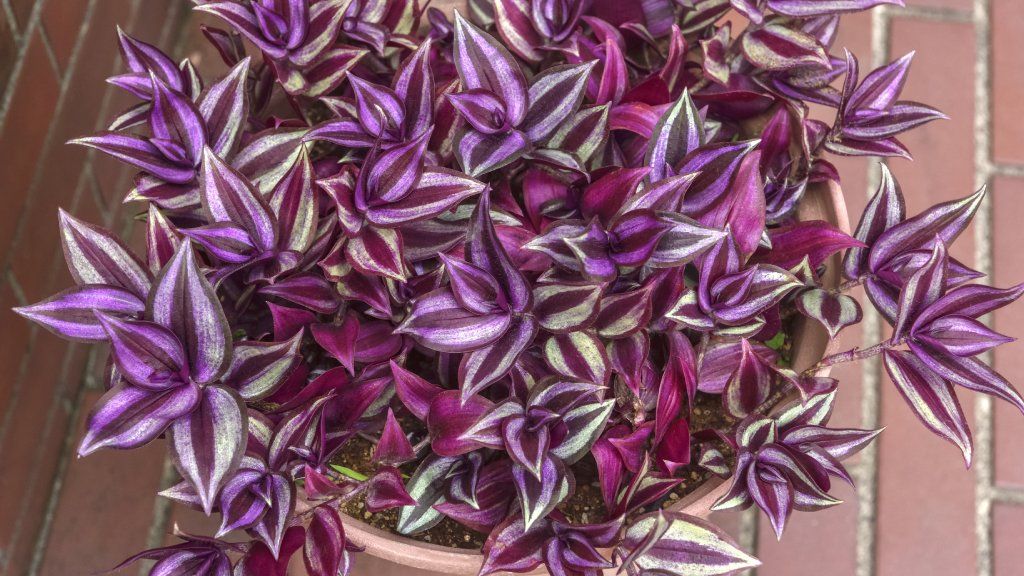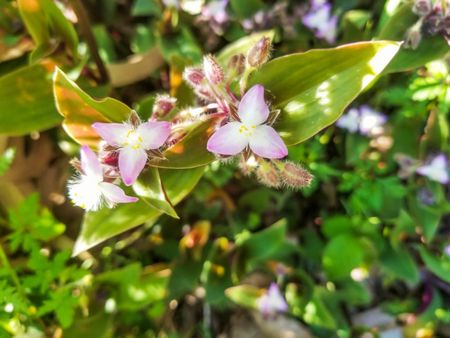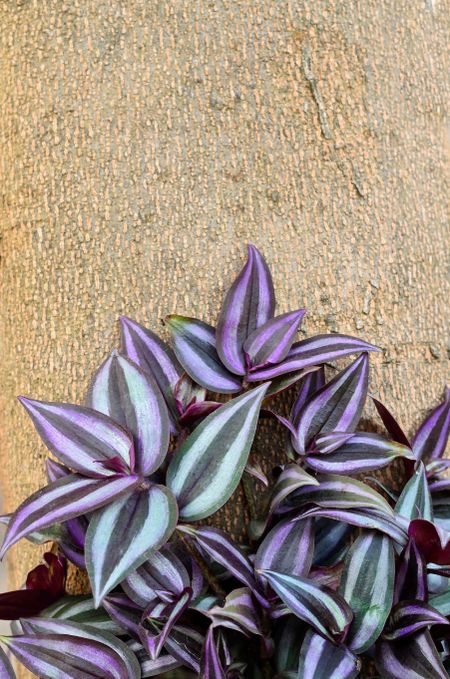Inch Plant Care Guide: How To Grow Tradescantia Zebrina
The familiar creeping inch plant is such an easy houseplant to grow and propagate, it may reveal your green thumb.

Quick Inch Plant Facts:
- Botanical name - Tradescantia zebrina
- Height - 6 to 8 inches (15.2 to 20.3 cm)
- Spread - 12 to 24 inches (30.5 to 61.0 cm)
- Sun exposure - Full sun to partial shade
- Soil requirements - Moist, well-drained
- USDA Hardiness zones - 8 to 12
- When to plant - Year-round indoors
The Inch plant, also known as creeping inch plant and zebra inch plant, is a tropical perennial that is mostly grown as a popular houseplant in North America. Tradescantia zebrina plants are fast-growing, easy to care for, attractive in containers and hanging pots, and easy to share with friends.
About Inch Plant
Tradescantia zebrina is a trailing, perennial groundcover native to southern Mexico and parts of Central America. Because it is not hardy in most of North America, it is largely used as an ornamental houseplant.
The inch plant gets its name due to the uniform spacing between leaf nodes, but it also accurately describes its pace of growth. It grows quickly, creating attractive, trailing branches with green foliage that is striped with silver and purple on the underside. Inch plants produce small light purple flowers, but the foliage is the main draw.
While most commonly used as a houseplant, you can also grow inch plants outdoors as an annual in colder climates and as a perennial groundcover in regions where it is hardy. As an annual, plant it in containers or in the ground. Inch plants look nice as trailing ground cover and hanging baskets.
Easy Inch Plant Care
Aside from the attractive foliage, inch plants are popular as a houseplant for their low maintenance needs. It grows readily and quickly, even when neglected a little bit. Here are a few tips on creeping inch plant care.
Sunlight
Inch plants require bright, indirect light. If the light is too dim, the distinctive leaf markings will fade. In the wild, inch plants tolerate full sun and partial shade. As a tropical groundcover, it also grows naturally in bright, filtered sunlight. As a houseplant in northern climates, the inch plant produces better foliage color in bright, direct light. In warmer southern climates, too much sunlight has the opposite effect and will wash out the striking colors on the leaves.
Watering
Keep the inch plant’s soil slightly moist but don’t water directly into its crown. Remember that this plant does not like wet feet. Don’t let it sit in soggy soil, and let it dry out a bit before watering. In winter when indoor air is dry, it’s a good idea to mist inch plants frequently.
Gardening tips, videos, info and more delivered right to your inbox!
Sign up for the Gardening Know How newsletter today and receive a free copy of our e-book "How to Grow Delicious Tomatoes".
Trimming
An important part of growing inch plants is pinching back the long, vining tendrils. Pinch back about a fourth of the plant regularly to encourage branching and increase its fullness. This will keep the plant from becoming too leggy.
Fertilizing
It’s acceptable to feed your inch plant monthly with a diluted half-strength liquid fertilizer. However, this may be more appropriate in spring and summer during the plants’ growth period. In winter, if the plant is not receiving as much sunlight, it does not require feeding. One expert advises fertilizing every seventh watering. It’s important to observe the plant. If it’s in a growth stage it will need more nutrients; if not, let it rest. Use a balanced houseplant fertilizer.
Tradescantia zebrina Propagation
Your inch plant eventually will lose its leaves at the base, while its long legs keep growing. This means it's time to renew your plant by taking cuttings and rooting them. Don't be surprised if your plants need to be renewed once a year or so.
One reason this plant is so well loved is because it’s easy to propagate and share using cuttings. When trimming the inch plant back to keep it healthy, place the cut tendrils in water, removing any bottom leaves. The cuttings will root quickly and can soon be shared and planted.
Even easier way to propagate the inch plant is to cut off some of the plant’s long legs and simply bury the cut ends in fresh potting soil. Keep the soil moist and within a few weeks, you’ll see new growth. Always make sure your soil is fresh, as salt build up in old soil is lethal to inch plants.
You may also notice that inch plant tendrils lying on top of the soil will root themselves at each joint of the stem. These can be removed individually and planted as separate small plants.
Pests, Diseases, and Problems
Some pests that might trouble your inch plant are aphids, spider mites, whiteflies, scale, and mealybugs. Check plants regularly for any sign of pests, so you can manage the issue early.
If your plant develops browning leaves, it may be experiencing root rot, not enough water or too much heat, or in some cases, simply old age. Remove the brown leaves, inspect your inch plant for pests, then evaluate its growing conditions.
Inch Plant Varieties
There are not many different varieties or cultivars of Tradescantia zebrina. A few exist that are not significantly different in appearance from each other: ‘Purpusii,’ ‘Tricolor,’ and ‘Quadricolor.’
You can find some other species of Tradescantia with different traits:
- T. cerinthoides. This species has green leaves and grows even faster than the inch plant.
- T. pallida. Also known as Purple Heart, this species has purple foliage.
- T. spathacea. Oyster plant is also known as Moses-in-a-basket. It has foliage that looks similar to inch plant and flowers that resemble oysters.
- T. fluminensis. This species is native to South America and has trailing stems with green leaves. Cultivars include those with variegated leaves and purple coloring.
- T. chrysophylla. Also called baby bunny bellies, this species gets its common name from its soft, fuzzy leaves.
Tradescantia zebrina’s easy care and unique foliage and growth habit have made this a popular houseplant. Minimal care, some careful pruning, and adequate sunlight are all you need to enjoy an inch plant in your home. Be advised that Inch plants have a relatively short lifespan, and do not always age well. Regardless of how attentive your inch plant care may be, before long it may lose its leaves at the base, while its long legs keep growing. This means it’s time to renew your plant by taking cuttings and rooting them. Don’t be surprised if your inch plants need to be renewed in this way once a year or so.

Mary Ellen Ellis has been gardening for over 20 years. With degrees in Chemistry and Biology, Mary Ellen's specialties are flowers, native plants, and herbs.
-
 Best Tomatoes For Containers: 10 Tastiest Varieties For Plentiful Produce In Compact Areas
Best Tomatoes For Containers: 10 Tastiest Varieties For Plentiful Produce In Compact AreasThese are the best tomatoes for containers that prove you don't need to have a large space or elaborate garden to grow delicious produce.
By Bonnie L. Grant
-
 Ultimate Potted Flowers For Spring: 8 Brilliant Blooming Options for Spring Containers
Ultimate Potted Flowers For Spring: 8 Brilliant Blooming Options for Spring ContainersCelebrate the most uplifting of seasons with the most dazzling container flowers imaginable. Here, we present some of the loveliest potted flowers for spring…
By Tonya Barnett
-
 Rooting Inch Plants: How To Propagate Tradescantia Inch Plants
Rooting Inch Plants: How To Propagate Tradescantia Inch PlantsInch plant is a pretty houseplant that creeps over the edge of containers. Read on to learn how propagate inch plant cuttings.
By Mary Ellen Ellis
-
 Killing Inch Plants: How To Get Rid Of Inch Plant Weeds In The Garden
Killing Inch Plants: How To Get Rid Of Inch Plant Weeds In The GardenInch plant (Tradescantia fluminensis) is very invasive and should be treated with caution. Click here to learn about inch plant weed control.
By Liz Baessler
-
 Growing Inch Plant Outside: How To Plant Inch Plant Outdoors
Growing Inch Plant Outside: How To Plant Inch Plant OutdoorsThe inch plant is truly one of the easiest plants to grow as a houseplant due to its adaptability. But can inch plant survive outdoors?
By Amy Grant

